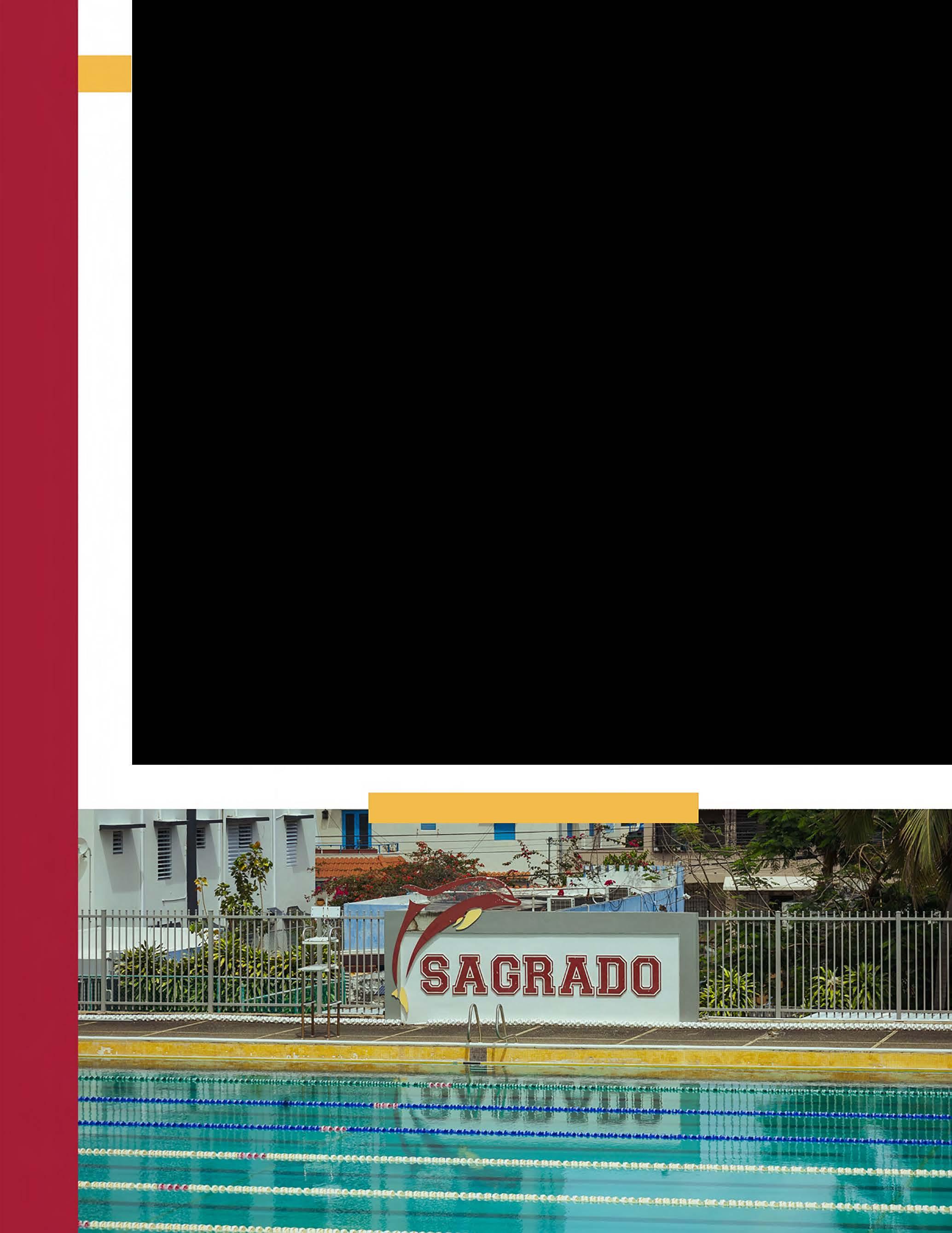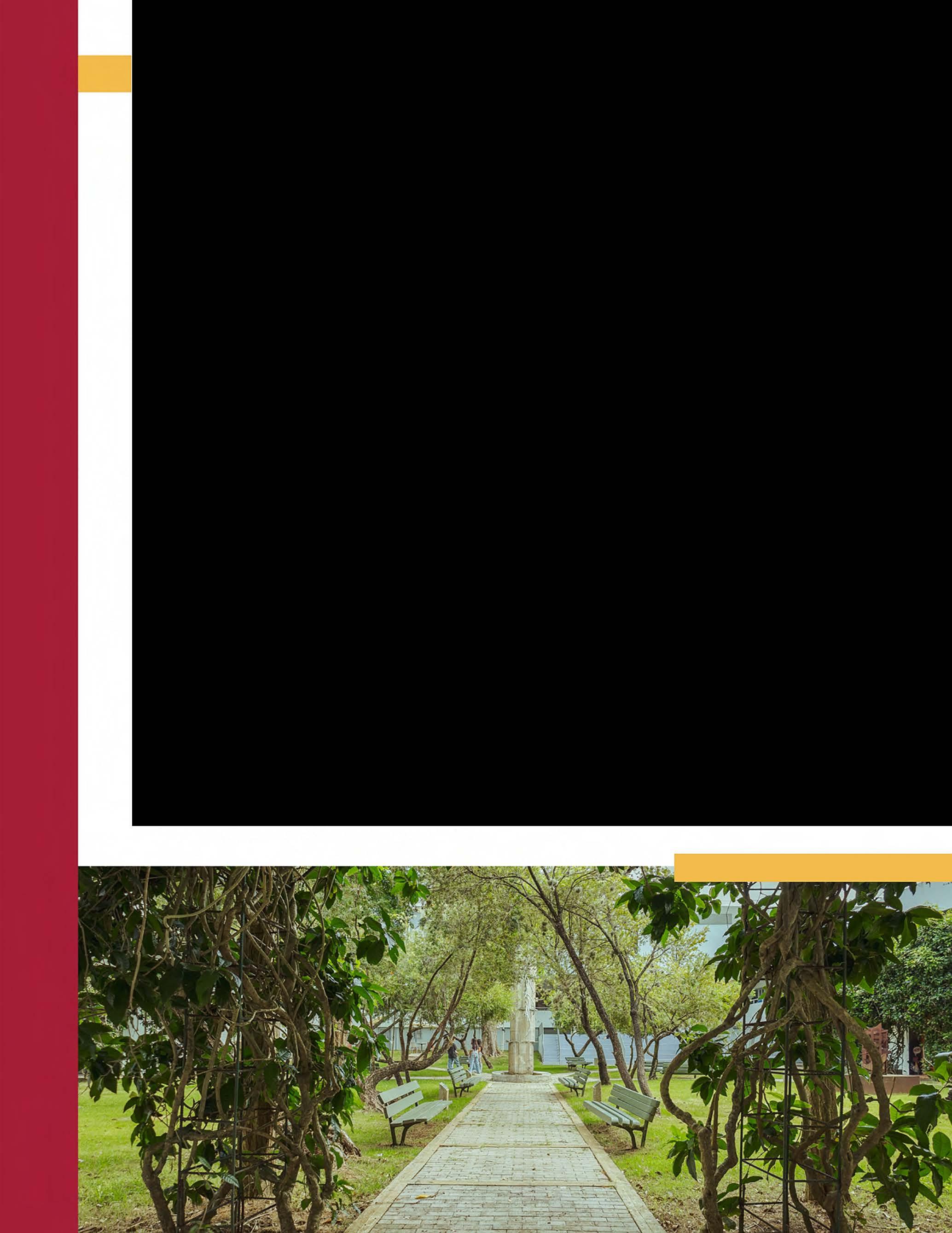SAGR ADO 2030

S T R A T E G I C P L A N
Universidad del Sagrado Corazón
June 16, 2025










S T R A T E G I C P L A N
Universidad del Sagrado Corazón
June 16, 2025









A.4 Continue to align student services into an integrated model that fosters belonging, supports retention, and meets the diverse needs of all students through coordinated advising, mental health suppor t, enriched student life, and personalized communication.
1. Beginning August 2025, ensure that at least 50% of unique students participate annually in one or more student life activities or organizations, tracked through attendance and membership data.
A. Owner: Student Affairs (Student Life)
2. Beginning in August 2025, we will monitor and improve student satisfaction through personalized communications, aiming to achieve a 90% satisfaction rate by May 2030 based on survey data and usage metrics.
A. Owner: Integrated Communications
3. By December 2026, complete a comprehensive assessment of current student services and submit a proposal for an integrated services model; implement all necessary process changes by August 2027.
A. Owner: Student Afairs, Academic Affairs (Student Success Unit), and Enrollment Management
4. Beginning June 2025, establish a baseline for the percentage of students who access academic and career advising services at least once per semester and set year-over-year growth targets.
A. Owner: Academic Affairs (Student Success Unit and CEPI)
5. Beginning August 2026, achieve and maintain at least 70% student awareness of available mental health services, as measured through annual surveys; monitor usage rates to assess effectiveness.
A. Owner: Student Affairs, with support from Academic Affairs (survey development) and Integrated Communications (campaigns)
6. By August 2028, implement a Service Desk tool integrated with an omnichannel student support platform-including chatbot and ticketing systems-to ensure consistent and timely assistance.
A. Owner: IT, in collaboration with Student Affairs and Academic Affairs (Student Success Unit)


A.6 Establish a continuous public recognition program to acknowledge the academic, professional, athletic, and extracurricular achievements of students to promote their motivation, their sense of belonging to Sagrado, and engagement with their integral development.
1. By August 2025, design and implement an institutional student recognition program, including defined criteria, recognition categories and visibility strategies; and implement a digital platform or system to track and showcase student recognitions.
A. Owner: Student Affairs
2. Beginning August 2025, annually communicate to 100% of undergraduate and graduate students the distinctions granted by Sagrado.
A. Owner: Student Afairs
3. Beginning in 2026, organize a minimum of four public recognition events or campaigns per academic year (e.g., ceremonies, digital badges, social media spotlights) to ensure broad participation and institutional promotion.
A. Owner: Student Affairs
4. By May 2030, at least 90% of students who receive recognition will report a strong sense of belonging and increased motivation, as measured through annual surveys conducted after recognition.
A. Owner: Student Affairs
5. By June 2030, at least 90% of students formally recognized through the program will remain enrolled at Sagrado through graduation.
A. Owner: Student Affairs
A.7 Continue enhancing the Student Journey by standardizing response times and service standards, ensuring reliable internet connec tivity, and integrating sy stems across enrollment, recruitment, and support services to provide a seamless and efficient experience.
1. By July 2026, Implement a unified CRM system and optimize the admissions process t o ofer differentiated services for traditional, transfer, international, and adult learners.
A. Co-Owners: IT, Admission, and Enrollment Management (with support from the Student Success Unit)
2. By July 2027, achieve 99% uptime for high-speed internet connectivity across all student-accessible areas on campus.
A. Owner: IT
3. By December 2027, launch a Student Service and Care Culture Program, including defined service quality indicators and baseline satisfaction metrics.
A. Owner: Student Affairs (with support from the Student Success Unit, Integrated Communications, and HR)
4. By May 2028, reduce registration time and related errors by at least 60% through process redesign and technology integration.
A. Co-Owners: IT and Enrollment Management (with support from the Student Success Unit)
5. By December 2028, increase overall student services process efficiency by 80%, based on findings from annual system evaluations and platform performance audits.
A. Co-Owners: IT, Admission, and Enrollment Management (with support from the Student Success Unit)
STRATEGIC PLAN

A.8 Continue to foster an organizational culture that balances operational needs, personal and family contexts, and professional development by introducing flexible work policies, family support initiatives, and leadership development programs to create high-performance teams and improve overall employee satisfaction and engagement. Baseline benchmarks will be established during the first year of implementation, after which specific measurable targets will be defined based on institutional data and capacity.
1. By July 2026, implement a work plan to address the institutional priorities and needs identified in the June 2025 Climate Culture Survey.
A. Owner: Human Resources
2. By July 2026, assess and improve, as needed, flexible work policies-including remote/hybrid work, flexible hours, and job-sharing options.
A. Owner: Human Resources
3. By July 2026, establish a baseline employee retention rate, including tracking of employees utilizing flexible work arrangements, personal or family support policies, and professional development opportunities.
A. Owner: Human Resources
4. By August 2026, implement an annual employee satisfaction and engagement survey, establish a baseline benchmark, and track year-over-year improvements.
A. Owner: Human Resources
5. By August 2026, position Sagrado Global as a strategic platform for internal professional development by offering tailored non-credit programs to faculty and staff, promoting a culture of lifelong learning and institutional investment in human capital.
A. Owners: Human Resources and Academic Affairs (Sagrado Global)
6. By July 2027, evaluate existing employee support programs (such as parental leave and paid time off ) and identify areas for improvement-including the possible incorporation of incentives or childcare support-to promote better work-life balance and increase employee satisfaction.
A Owner: Human Resources
7. By July 2027, complete a comprehensive review and present a proposal for a revised compensation and incentive scale for staff personnel, including evaluation of retirement savings plan contributions and performance-based incentives.
A. Owners: Human Resources, Finance, and Academic Affairs (Provost's Office)
8. By July 2027, Design and implement leadership development programs, ensuring alignment with institutional goals, employee career progression, and succession planning.
A. Owner: Human Resources
9. By July 2028, assess and revise the performance review process to ensure alignment with institutional goals and employee development needs; establish performance benchmarks to track improvements in collaboration, efficiency, and outcomes.
A. Owner: Human Resources
10. By June 2030, implement strategies to enhance overall employee retention, building upon the baseline established in July 2026.
A. Owner: Human Resources
STRATEGIC PLAN

A.9 Establish a comprehensive and effective program to recruit, develop, and retain top-tier faculty, ensuring institutional succession and operational continuity.
1. By December 2026, design and implement a revised annual faculty evaluation process that includes clear criteria tied to mobility across salary scale categories, supporting career advancement, and equitable professional development.
A Owners: Academic Affairs (Provost's Office, Schools, and Academic Operations), Human Resources, and Finance
2. By December 2025, publish the faculty development work plan, developed with input from faculty and led by the Pedagogical Innovation Unit.
A. Owner: Academic Affairs (Provost's Office, Schools, and Pedagogical Innovation)
3. By February 2026, complete the analysis and planning of faculty hiring, retention, and succession initiatives for the next five years.
A. Owner: Academic Affairs (Provost's Office, Schools, and Academic Operations)
4. By February 2027, analyze compensation scales for library personnel, assess alignment with academic support functions (e.g., research assistance), and develop a plan to adjust compensation and strengthen professional development in areas such as information literacy, data management, and academic research support.
A. Owners: Academic Affairs (Provost's Office, School of General Education, Madre Marfa Teresa Guevara Library, and Academic Operations), Human Resources, and Finance
5. By December 2026, conduct a market analysis of adjunct faculty compensation and revise the compensation structure as needed to ensure competitiveness and alignment with institutional goals.
A. Owners: Academic Affairs (Provost's Office, Schools, and Academic Operations), Human Resources, and Finance
6. By June 2030August 2027, reduce the student-to-full-time faculty ratio to enhance instructional quality, balance faculty workload, and foster greater engagement.
A. Owners: Academic Affairs (Provost's Ofice, Schools, and Academic Operations), Human Resources, and Finance
7. By June 2030, increase the percentage of full-time faculty with a PhD degree to 80%, supporting academic excellence and institutional competitiveness.
A. Owners: Academic Affairs (Provost's Office, Schools, and Academic Operations), Human Resources, and Finance.
STRATEGIC PLAN
A.10 Implement a reliable system to collect, analyze, and visualize institutional data and make it available to all operational areas to support decision-making, continuous improvement, and strategic development.
1. By February 2027, conduct a baseline data maturity assessment to evaluate institutional capacity i n data governance, integration, and utilization.
A. Co-Owners: IT and Data Management Unit
2. By August 2027, enhance and optimize the co- and extracurricular transcript by establishing standardized data points that support institutional reporting needs for licensing, accreditation, and grant applications.
A. Owners: IT, Student Afairs, and Academic Affairs
3. By November 2027, finalize the selection and onboarding of the Data-as-a-Service (DaaS) platform, with full operational integration by August 2028.
A. Owner: IT
4. By March 2028, publish a data governance framework to ensure consistency, security, and accountability in data use across units; update the framework quarterly thereafter.
A. Owner: IT
5. By June 2028, ensure that 100% of data pipelines between CRM, SIS, LMS, and HR systems meet interoperability and data quality standards.
A. Owner: IT
6. By December 2028, implement a centralized data warehouse and achieve 90% adoption by all relevant departments for data management and research purposes, including dashboards on enrollment, retention, persistence, and graduation rates, student profile data (e.g., demographics, academic standing), student engagement, and others aspects, among others.
A. Owners: IT and Data Management Unit


STRATEGIC PLAN
A.11 Establish and operationalize a centralized CRM system and Student Portal to track, evaluate, and optimize marketing and recruitment efforts, with full adoption by marketing and admissions teams.
1. By July 2026, complete the evaluation of Phase 1 of the digital transformation to enhance marketing optimization with a revamped CRM system and development of Student Portal.
A. Co-Owners: Marketing/Admissions and IT
2. By July 2026, la unch Phase 1 of the CRM system and Student Portal to support targeted ou treach and recruitment
A. Co-Owners: Marketing/Admissions and IT
3 By February 2026, ensure that 100% of marketing and admissions staff complete training sessions led by IT consultants on the use of the CRM system and Student Portal.
A. Owners: Marketing/Admissions and IT
4. By April 2026, ensure that 100% o f trained marketing and admissions staff actively use the CRM system and Student Portal in daily operations.
A. Owner: Marketing/Admissions and IT
5. By June 2026, implement the needed standardized dashbo ards or reports for tracking campaign performance and prospect behavior.
A. Co-Owners: Marketing/Admissions and IT
6. By July 2026, achieve 90% capture and tracking of prospective student data thro ugh the CRM system.
A. Owner: Marketing/Admissions
7. Beginning December 2026, track and report annually the number of optimization actions taken based on insig hts generated by the CRM and Student Platform.
A. Owner: Marketing/Admissions and IT
8. Beginning July 2026, define and reduce the time-to-insight (the average time from campaign launch t o performance reporting) and monitor it quarterly for continuou s improvement.
A. Owner: Marketing/Admissions


STRATEGIC PLAN

A.12 Implement Phase I of the Facilities Master Plan by integrating smart security technologies, sustainable automation pilot projects, and mobility/accessibility enhancements while establishing a campus-wide resiliency framework to ensure operational continuity and infrastructure modernization in alignment with institutional strategic goals.
1. By June 2028, strengthen business resiliency by finalizing and implementing a Business Continuity Plan, Incident Response Plan, and Disaster Recovery Plan, with annual testing and updates scheduled every March thereafter.
A. Owner: Operations
2. By May 2028, enhance campus mobility and accessibility by implementing a digital platform for parking permits and providing real-time space availability infrmation.
A. Owner: Operations
3. By June 2028, promote innovation and sustainability by launching a t least one pilot smart recycling initiative in the major campus hubs .
A. Owner: Operations
4. By December 2029, enhance campus safety by completing the upgrade of all access control systems with smart card readers and mobile credentials across academic, residential, and administrative buildings.
A. Owner: Operations
5. By December 2029, promote sustainability by completing the development of green infrastructure, including renewable energy alternatives and sustainab le water supply systems.
A. Owner: Operations
6. By December 2029, improve campus mobility by completing redesigns of key pedestrian pathways and si gnage.
A. Owner: Operations
7. By June 2030, develop and implement a Facilities Master Plan that outlines priorities for infrastructure modernization, sustainability initiatives, space utilization, and utilities improvement in suppo rt o f strategic enrollment and academic growth goals.
A. Owner: Operations
8. As part o f Phase I o f the Facilities Master Plan, implement the Casa Mater mechanical A/C project, achieving at least a 30% improvement in energy consumption efficiency and enhanced building aesthetics.
A. Owner: Operations


Embracing the international spirit of the Society of the Sacred Heart, the founder of Sagrado's educational project, this goal transforms Sagrado into a bilingual, globally connected institution. It expands recruitment into U.S. and international markets, establishes academic partnerships with top global institutions, and implements a bilingual curriculum in Spanish and English.
Advanced academic tracks will attract high-achieving students, while tailored support services-inclu ding mentorship, housing, and cultura I integration-will foster student success. Expanded housing capacity will support growth and enrich residential life, strengthening Sagrado's global reach and inclusive campus community.
B.1 Research to develop and implement st rategies to begin undergraduate recruit ment of U.S. students and non-U.S. international students.
1. Completion of market research reports for U.S. and international segments by [April 2026) and aligned with Sagrado's ofering. The following metrics will be adjusted fllowing the market research:
• # of targeted recruitment markets identified and activated by [Month, Year].
• # o f U.S. states and international regions with active undergraduate marketing by [Month, Year].
• # of international undergraduate applications received by [Month, Year].
• % of new enrollments from U.S. and international markets by [Month, Year].
• # of international par tnerships or feeder school agreements established by [Month, Year].
2. Owner: Marketing/Admissions






STRATEGIC PLAN
B.S Assess capacity and begin developing new student housing on or near campus by June 2030 by the capacity needs.
1. Complete a comprehensive student housing capacity assessment by August 2027, including current inventory, demand trends, and student preferences.
A. Owner: Business Development Unit and Operations
2. Beginning in 2027, produce an annual report that includes occupancy rates, enrollment projections, and a housing gap analysis, with actionable recommendations submitted to university leadership.
A. Owner: Business Development Unit and Operations
3. Identify and evaluate potential sites for new student housing-on or near campus-by December 2027.
A. Owner: Business Development Unit and Operations
4. Ensure that student housing development plans are aligned with projected enrollment growth targets (e.g., 10% increase by 2030) and the broader goals of Strategic Plan 2030.
A. Owner: Business Development, Operations, and Communications
5. By June 2028, assess the need to incorporate family residential accommodations within the student housing portfolio to support student-parents and enhance retention, especially concerning new doctoral programs.
A. Owner: Business Development Unit and Operations
6. Fully meet projected student housing needs by June 2030 through new construction, renovation, or partnership agreements, ensuring housing capacity supports expected enrollment.
A. Owner: Business Development Unit and Operations




6. Increase the percentage of graduate-level faculty with terminal degrees (PhDs or equivalent) to at least 90% by June 2028.
A. Owner: Academic Afairs (Provost's Office, Schools, and Academic Operations), Human Resources, and Finance
7. Implement an annual graduate student survey beginning in August 2025 to assess motivation, satisfaction, reasons for program selection (e.g., modality, pacing), and alignment with career goals.
A. Owner: Academic Affairs (Provost's Ofice and Schools)
8. Maintain a graduate retention rate above 78% and a graduation rate above 74% annually, beginning in AY 2026-27.
A. Owner: Academic Affairs (Provost's Ofice, Schools, and Student Success Unit)
C.2 Create the foundation for doctoral programs by defining the aca demic structure, selecting priority research areas, developing faculty research capacity, and establishing funding and scholarship models to support high-quality doctoral education and strengthen the University's academic reputation.
1. Define and develop the academic structure of the Sagrado Graduate School, ensuring the readiness of its core research infrastructure (e.g., labs, digital and physical library resources, doctoral advising structures, IRB process) by December 2025.
A. Owner: Academic Affairs (Provost's Office, Schools, Academic Operations)
2. Submit doctoral program proposals from the School of Arts, Design, and Creative Industries, the School of Health and Sciences (Nursing), and the Ferre Rangel School of Communication to JIP before December 2025.
A. Owner: Academic Affairs (Provost's Office and Schools)
3. By June 2027, the institution will establish a dedicated faculty researcher category within the salary scale and design compensation structures for research assistants and teaching assistants (TAs) to support the development of its doctoral programs.
A. Owner: Academic Affairs (Provost's Office, Schools, Academic Operations) and Finance
4. Submit MSCHE substantive change proposal as soon as JIP approval is received.
A. Owner: Academic Affairs (Provost's Office)
5. Align institutional resource investments, including budget allocations, facilities, and staffing plans, with the implementation milestones of new doctoral programs by the time these degrees are launched.
A. Co-Owners: Academic Affairs (Provost's Office, Schools, Academic Operations) and Finance


C.4 Develop and launch a hybrid (virtual and in-person) Global Professional Networking Series for alums and institutional allies, designed to foster continuous learning, professional growth, and global engagement beyond graduation.
1. Develop and implement a lifelong learning framework for alums by June 2026, including short courses, networking opportunities, and career advancement tools, with annual participation benchmarks.
A. Co-Owners: Academic Affairs and Development (Alumni Office)
2. By June 2026, host at least 4 hybrid networking events annually (two per semester), with participation from alumni, partners and active students.
A. Owner: Development (Alumni Office)
3. Achieve cumulative participation of at least 100 alumni and allies across all events in the first year.
A. Owner: Development (Alumni Office)
4. Generate at least 8 documented collaborations (e.g., joint ventures, research projects, mentorships, or entrepreneurial initiatives) that arise from connections made through the series.
A. Owner: Development (Alumni Office)
5. Include post-event feedback surveys showing that at least 80% of participants report an increased sense of connection to Sagrado's global community and mission.
A. Owner: Development (Alumni Office)
C.5 Research to develop and implement strategies to maximize enrollment for current adult learners in Puerto Rico while developing a plan to recruit U.S. and non-U.S. international adult learners for both credit, non-degree seeking, and non-credit professional and academic programs.
Conduct a research study by May 2026 to analyze trends, competition and size of the opportunity for enrollment in credit, non-degree seeking, and non-credit professional and academic programs (Depends on final budget approval)
1. 4% increase in enrollment of Puerto Rico adult learners (credit and non-credit) by [June 2030).
2. Completion of U.S./international adult learner market analysis by [Month, Year]. The following metrics will be adjusted to the market research results:
•# of new marketing campaigns targeting adult learners (US & international) by [Month, Year].
• % increase in international adult learner inquiries/applications by [Month, Year].
• % of adult learners enrolling in stackable or lifelong learning pathways by [Month, Year].
• # of corporate or international partners involved in adult learner recruitment by [Month, Year].
A. Owner: Marketing and Academic Affairs (Sagrado Global)


belonging by promoting
Sagrado will reinforce its Catholic, mission -driven identity and global recognition by unifing its brand nar rative across all communications. Centro Soffa will lead theological reflection, spiritual frmation, and interdisciplinary dialogue through academic par tnerships and published activities. Mission-driven prog ra ms-including volu nteerism, CoMesa, and religiou s tou rism-wi 11 expand through greater engagement and funding.
Alum's inv olvement in service and giving will strengthen community ties and showcase Sagrado's values in action.
D.1 Position Universidad del Sagrado Coraz6n as a globally recognized institution by reinforcing a unified value proposition and brand identity-grounded in its mission, history, and community impact-integrated across 100% of academic and marketing communications, supported by a comprehensive visual and verbal identity toolkit, and adopted through staff and faculty training, with measurable increases in brand awareness and stakeholder trust.
1. By June 2026, develop and implement a unified visual and verbal identity toolkit and train 100% of relevant faculty and staff in its proper use across academic, administrative, and promotional contexts.
A. Owner: Marketing and Communications
2. By December 2026, ensure that 100% of academic and marketing units integrate the institutional brand narrative-including mission, history, and Catholic identity-across all digital, print, and event communications.
A. Owner: Marketing and Communications


STRATEGIC PLAN

Strengthen instituti onal identity and belonging by promoting Sagrado's history, mission, and Catholic and Christian values.
3. By December 2026, conduct a baseline institutional identity perception survey among internal (students, faculty, staff) and external (alums, employers, community partners) audiences. Beginning in August 2027, continue to track perceptions every three years to assess changes over time.
A. Owner: Marketing and Communications
4. By July 2027, begin tracking and reporting annual growth in brand awareness and trust scores across key stakeholder groups (students, alums, employers, and partners) using institutional surveys and engagement analytics.
A. Owner: Marketing and Communications
5. By December 2027, develop and implement strategies to position Sagrado as a local and international leader in community engagement, highlighting its distinctive recognition by the Carnegie Foundation for the Advancement of Teaching as the only university in Puerto Rico to hold this classification.
A. Owners: Marketing, Communications and Academic Affairs
D.2 Conduct theological reflection and research activities for students, faculty, administrators, and the broader community, fostering interdisciplinary dialogue through collaborative ecumenical partnerships and alliances with academic, theological, and international pastoral institutions.
1. Beginning August 2025, achieve at least 95% implementation of planned annual theological reflection activities (e.g., symposiums, congresses, conferences, seminars, talks, webinars) annually.
A. Owner: Centro Soffa with collaboration from Academic Affairs
2. Beginning August 2025, execute at least one research activity annually focused on theological or interdisciplinary themes.
A. Owner: Centro Soffa with collaboration from Academic Affairs
3. Beginning January 2026, publish at least 50% of annual theological reflection activities in academic or public-facing formats (e.g., proceedings, recorded webinars, publications, institutional repositories).
A. Owner: Centro Soffa with collaboration from Academic Affairs and Integrated Communications
4. Beginning August 2026, achieve a 50% annual increase in participation across the university community in planned theological reflection activities.
A. Owner: Centro Soffa
5. Establish and maintain at least three (3) collaborative alliances with theological or pastoral institutions (academic, ecumenical, or international) by August 2027.
A. Owner: Centro Soffa and the President's Office




E.2 Implement targeted strategies to grow external sponsorship from private entities, corporations, and third-party organizations, expanding the University's revenue base and institutional impact.
1. Develop and implement a Sponsored Funding Development Plan by December 2026, which includes mechanisms for identifying funding opportunities aligned with institutional priorities, strategies to increase faculty proposal submissions, and annual capacity-building workshops on grant writing and proposal development.
A. Owner: Academic Affairs
2. Increase externally sponsored project funding to represent at least 5% of total institutional revenue by June 2030.
A. Owner: Finance and Academic Affairs
E.3 Establish a new unit dedicated to generating and maximizing income through the monetization and commercialization of University assets.
1. Complete a comprehensive inventory of university assets with commercialization potential, including established pricing structures and promotional materials, by December 2025.
A. Owner: Business Development
2. Reach 15% of total institutional revenue from commercial operations by June 2030.
A. Owner: Business Development
3. Launch at least four new commercial initiatives-such as university-branded products, licensing agreements, naming rights, or service-based ventures-by June 2027.
A. Owner: Business Development, Development, Legal, Communications
4. Secure at least four new external partnerships or joint ventures to expand commercial revenue streams by June 2028.
A. Owner: Business Development, Development, Legal




E.S Implement a comprehensive strategy to reduce energy and water costs
and improve infrastructure efficiency through sustainable practices, space maximization, and proactive maintenance policies. This includes optimizing the use of phy sical spaces, improving operational efficiency, and ensuring the durability and safety of campus buildings.
1. Implement a campus water well to the maximum allowed capacity and evaluate the need for an additional well to supply all university water needs by August 2028.
A. Owner: Operations
2. Achieve a 25% reduction in energy consumption through energy-efficient practices (e.g., LED lighting, temperature control measures) by June 2028.
A. Owner: Operations
3. Implement water-saving technologies to achieve a 25% reduction in water usage across campus by June 2030.
A. Owner: Operations
4. Execute a competitive procurement pro cess fr an alternative energy system to significantly reduce energy costs by August 2028.
A. Owner: Operations, Business Development and Finance
5. Secure a 30% reduction in overall utility costs through efficiency measures and renewable energy adoption by June 2029.
A. Owner: Operations
6. Repurpose 85% of underutilized spaces by June 2029.
A. Owner: Operations, Academic Affairs, and Business Development
7. Ensure that 100% of campus buil dings have contingency plans in place by June 2029.
A. Owner: Operations
8. Establish and begin operation of intelligent and connected HVAC systems to reduce energy costs and improve efficiency by December 2029.
A. Owner: Operations
9. Maintain 90% annual compliance with the institutional buil ding inspection plan.
A. Owner: Operations
10. Ensure that 100% of buildings implement preventive maintenance plans by June 2030.
A. Owner: Operations
11. Assess the viability of developing and implementing incentive programs to promote alternative transportation methods, such as bicycling, among employees and students to reduce vehicular traffic and the campus carbon footprint.
A. Owner: Operations

E.6 Implement an efficient, integrated financial platform that streamlines budgeting, forecasting, and financial reporting across the institution.
1. Achieve full adoption of the new financial platform across all departments, ensuring at least 95% user participation by June 2030.
A. Owner: Finance and IT
2 Reduce the time required for monthly financial reporting by 60% through automation and system integration by December 2028.
A. Owner: Finance
3. Integrate at least five key financial functions-such as procurement, payroll, budgeting, grants, and accounts receivable-into the unified platform by December 2027 to improve operational efficiency.
A. Owner: Finance and IT
4. Achieve a 70% improvement in decision-making efficiency by providing real-time financial data and dashboards to key institutional stakeholders by February 2028.
A. Owner: Finance
E.7 Continue to streamline internal operations and external interactions (such as rentals, part-time faculty management, etc.} by implementing agile and user-friendly processes across the university, supported by Al-powered technologies.
1. Establish a Digital Operations Task Force by December 2028 to identify and implement "quick wins" for automation and digital efficiency.
A. Owner: IT
2. Conduct a comprehensive review and integration of core digital operational systems (e.g., procurement, HR, project management, facilities), achieving a 60% reduction in administrative processing time by September 2029.
A. Owner: IT, Finance, Human Resources, and Operations
3. Achieve 80% digital transition of core operational services across departments by September 2029, reducing reliance on manual processes and enhancing access.
A. Owner: IT
4. Ensure 90% of administrative functions are paperless by December 2029, supporting the University's sustainability and digital transfrmation goals.
A. Owner: IT
5. Integrate Al-powered technologies into key administrative areas (e.g., admissions, Finance, facilities management, academic planning), resulting in a 15% reduction in operational costs by December 2029.
A Owner: IT
6. Deploy at least 3 Al use cases across admissions, Finance, and facilities by August 2029, achieving a 30% reduction in process times for targeted workflows.
A. Owner: IT
E.8 Implement an efficient, integrated financial platform that streamlines budgeting, forecasting, and financial reporting across the institution.
1. Achieve full adoption of the new financial platform across all departments, ensuring at least 95% user participation by June 2030.
A Owner: Finance and IT
2. Reduce the time required for monthly financial reporting by 60% through automation and system integration by December 2027.
A. Owner: Finance
3. Integrate at least five key financial functions-such as procurement, payroll, budgeting, grants, and accounts receivable-into the unified platform by December 2027 to improve operational efficiency.
A. Owner: Finance and IT
4. Achieve a 70% improvement in decision-making efficiency by providing real-time financial data and dashboards to key institutional stakeholders by February 2027.
A. Owner: Finance


